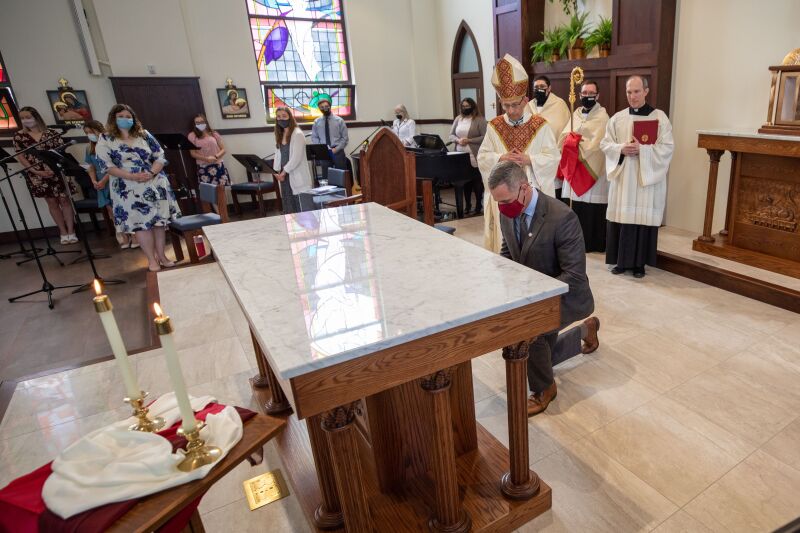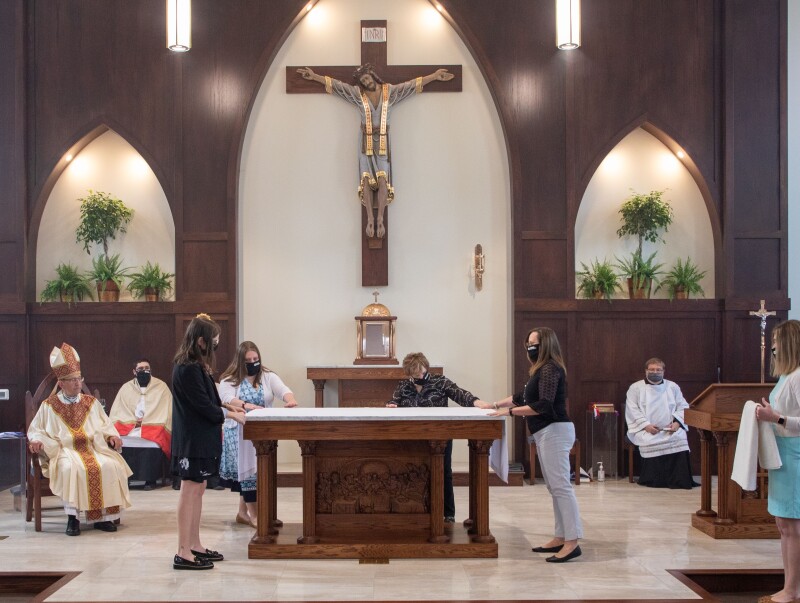
DEDICATION FOR SACRED PURPOSE
Sheila Grove
04/26/2021
ERIE — “At the beginning of the Gannon chapel dedication Mass, the altar was just a beautifully ornate wooden and marble table, no different from any other. But at the middle of the Mass once the altar had been anointed, blessed and incense burned on it, it had become a living symbol of the risen Christ in our midst and the place where the sacrifice of the Mass is offered,” says Father Chris Singer, chancellor for the Diocese of Erie.

Strategy and Campus Operations, seals relics under the
altar at the dedication of Mary, Seat of Wisdom Chapel.
Photo/Courtesy of Gannon University
On Sunday, April 18, students, alumni, benefactors, faculty and diocesan representatives witnessed the transformation of the altar and the chapel space around it at the dedication of Mary, Seat of Wisdom Chapel at Gannon University in Erie. It was a solemn event that may have been a once-in-a-lifetime experience for many.
As most of the churches in the Diocese of Erie were dedicated long ago, many Catholics in northwest Pennsylvania have not witnessed the richness of the rite that dedicated — or set aside for a sacred purpose — the place in which they worship. Newer churches or those that have undergone extensive renovation or have a new altar also have been dedicated at a Mass like the one at Gannon.
A Catholic place of worship is called a church because the people of God gather there. Each time they enter the holy space to pray or participate in worship, they do so as the living body of Christ. It is fitting that dedicating the building for this purpose is one of the most solemn rites in Catholic tradition.
The rite of dedication of a church, chapel or altar takes place during a Mass and begins with a procession, much like other Masses. There is, however, no genuflecting in front of the still-empty tabernacle or reverencing the not-yet-anointed altar. The blessing of the space begins with a sprinkling rite. The bishop blesses water and with it sprinkles the people and then the walls of the church.

chapel dedication. Photo/Courtesy of Gannon University
The Liturgy of the Word begins with a reading from the book of Nehemiah recalling Ezra, a priest and scribe, proclaiming the book of the law so that the people of could hear and understand that the Spirit of God was among them. The second reading and Gospel are chosen from the lectionary for the rite of the dedication of a church.
After the Creed, the Litany of the Saints — invoking the intercession of holy women and men throughout the ages — for the well-being of the community that will assemble, replaces the Prayers of the Faithful.
In preparation for the Liturgy of the Eucharist, attention is turned toward the altar. According to the tradition of the church, the relics of martyrs or other saints are placed under the altar to signify the sacrifice of its members and the sacrifice of Christ. The relics are sealed and become a permanent part of the altar.
In one of the more dramatic moments of the ceremony, the bishop pours sacred chrism oil on the altar table, in the center and the corners before spreading it to cover the entire top. He or concelebrant priests then anoint the walls of the church by making the sign of the cross with the chrism.
Incense is burned in a brazier (pot) on the top of the altar reminiscent of ancient Jewish temple rites. The pleasing fragrance rising to God is a sign of the prayers of the people of God, who are also incensed as living temples of the Holy Spirit.

tabernacle at Mary, Seat of Wisdom Chapel for the first
time. Photo/Courtesy of Gannon University
The altar is then prepared for sacrifice and adorned with the altar cloth, flowers and a crucifix. The bishop blesses a candle which is used to spread light to the Paschal candle and candles throughout the church, including those inserted into sconces on the walls at the places that were anointed.
The rites of anointing, incensing, covering and lighting the altar and the worship space express visibly, the invisible work that the Lord accomplishes through the church in its celebration of the divine mysteries, especially the Eucharist. Notably, it is at this time of the Mass that the bishop approaches the altar and kisses it for the first time, as he usually does at the beginning of Mass.
The Liturgy of the Eucharist then proceeds as usual. After Holy Communion, the bishop reserves the Eucharist in a ciborium, which he then carries in procession around the church signifying the presence of the risen Christ in the people and the space. He places the ciborium in the tabernacle which had been open and empty. The sanctuary lamp is lit for the first time as an ongoing sign of the presence of the Eucharistic Lord in the tabernacle. The rite concludes as the Bishop blesses and dismisses the congregation.
Father Singer says of the transformation, “So now the building and the altar have become something extraordinary. We show signs of reverence in their presence. We bow when we approach or walk around the altar because of what it symbolizes and because what happens on it is sacred. We genuflect in front of the tabernacle. The building has changed because of the dedication and even our gestures reflect that. What has taken place is something special — now the church is dedicated for an extraordinary purpose.”
solemn liturgical actions. For the place where the Christian community is gathered to hear the Word
of God, to offer prayers of intercession and praise to God, and above all to celebrate the sacred
mysteries and where the Most Holy Sacrament of the Eucharist is reserved is a special image of the
church, which is God’s temple built from living stone. Moreover, the altar around which the holy
people gather to participate in the Lord’s sacrifice and to be refreshed by the heavenly banquet,
is a sign of Christ, who is the priest, the victim and the altar of his own sacrifice.
(The decree for the Sacred Congregation for the Sacraments and Divine Worship, May 29. 1977.)
The dedication of Mary Seat of Wisdom Chapel can be viewed here.
-
